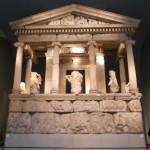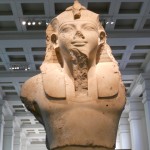September 22, 2010 · 1 Comment
As I and many others have mentioned in previous posts, examining religion and religious life in London has been a big part of our course. Central to increasing our knowledge and understanding of a number of religions has been visiting the various houses of worship. We have visited a few churches, a mosque, a mandir, and a synagogue. We have gone into these institutions with varying levels of welcome, and we have observed a variety of rituals, customs, and traditions.
Beauty has also been a recurring theme in the course. Almost all of the houses of worship that we visited had put serious thought and effort into the beautification of their buildings. The only exception was the mosque, but I think it is ok to assume that this was due to the financial circumstances of the community than lack of desire or appreciation for a beautiful space. In addition to all being beautiful, these spaces were all aesthetically very unique. The Mandir was extremely ornate, but not to the point of tackiness or fussiness. All of the stone and teak carvings were well executed and the building as a whole had a feel of luxury to it. The synagogue was a more simple, paired down building, but even as a more streamlined space, it still packed ample visual drama in the floor to ceiling red and gold mosaic behind the ark and tall, dramatic stained glass windows, which unfortunately had to be obscured by anti-terrorism curtains.
Comparing St. Paul’s and Westminster Abbey, aesthetically, St. Paul’s is the clear winner. Westminster Abbey is cluttered with tombs and plaques and statues, it is mostly dark and parts do look kind of shabby. Don’t get me wrong, it’s a place of great historical significance and cultural value, I’m not denying that, but on looks alone…. ehhh. St. Paul’s on the other hand, is light, airy, and spacious. It has a regal, elegant exterior and strikes a nice profile. The mosaics on the ceiling close to the WWII memorial were exceptional. As John explained to us, the tesserae had been set in at a specific angle, not flat against the wall, so that the sunlight reflects off of them just enough to allow them to glint and glitter. Perhaps over stepping here, but I think the visual atmosphere, the aesthetics of the particular houses of worship, reflect something of the character of the congregations who pray there.
Categories: 2010 Rachel · Uncategorized
Tagged: Architecture, churches, Hinduism, Mandir, Religion, St. Paul's Cathedral, synagogue, Westminster Abbey
September 22, 2010 · 1 Comment
I have a fondness for paintings, so its only natural that I gravitate towards museums such as the Tate Modern/Britain and the National Gallery. Some of the pieces I’ve seen from these particular museums have been no less than extraordinary. At the TM, I saw works by Monet and Pollock, discovering once again the beauty in blurred lily pads and splattered paint. But as the TM is also a purveyor of contemporary art, I was also able to see recent works that are – at times painfully – trying to subvert and re-express artistic theories. One of the more outstanding contemporary works I saw at the TM was a video installation by Carolee Schneemann. Made in 1964, Meatjoy is a manipulation of the filmic image as a veritable representation of reality into an exercise on sexual discourse that strives to create the notion that “sex” is in our own skin. Half naked men and women wrestle on the floor and arrange themselves in strange positions, as a hardly discernible voiceover of a woman is heard on the soundtrack. Gradually the cuts become more rapid, and people offscreen begin to throw meat and poultry at the “subjects.” Its shocking, even disgusting. But there is no nudity. Some images evoke sexual acts – but they are not sexual in and of themselves. Anyway, I didn’t particularly “like” the film, but it was interesting – and certainly shocking. You can view a short clip of it here: http://www.youtube.com/watch?v=D6AK9TI3-LU
Since the Tate Modern is a global museum and most of its exhibitions are free, there were a lot of people. The escalators and large spaces reminded me of a shopping mall. Its quite a contrast with the Charles Dickens museum, yet both are museums, right?
At the Tate Britain, I was greeted with a smaller crowd. The day that I went to the Tate Modern I was tired, and trying to view the artworks with an open mind is hard to do when there are hordes of people blocking the works from all angles. TB had no such problems. It itself is an impressive museum with an emphasis on British art (duh) but with a respectable collection of international modern art. I even saw a Mondrian painting. I must’ve been sitting in front of it for nearly half an hour. The painting’s greatest virtue is precisely that it is straightforward and pure. In this sense, its somewhat ironic to call it a piece of abstract art. I like it very much, and was impressed at the evocative power of a most primordial form. The painting even looks like a tatami, a seeming reference to the qualities of humility and tranquility that are intrinsic to Japanese culture.
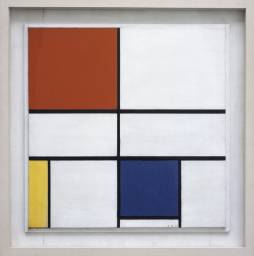
Mondrian: Composition C (No.III) with Red, Yellow and Blue
I saw advertisements about an exhibition at the TB exclusively on Eadweard Muybridge, arguably the first person to invent the ontological nature of the cinema. Enough said. The entrance fee was 10 pounds but I didn’t mind. The Muybridge was a fantastic exhibition, much more extensive that I had imagined; there must been at least six rooms. I also appreciated that there was a chronological order to the exhibition, beginning with Muybridge’s photographs from his early years to the prints from the zoetropes in his later. A proper tribute (and indeed, much deserving) to a pioneer who, although recognized in cinema history, unlike the Lumiere Brothers and Edison/Melies/Porter, is seldom talked about among academics and critics. Just looking at his prints, you realize how much of an influence he has had on the history of the medium. So grateful to have caught this. London has been good to me. If anything, one perk of living in the city is, simply, the range and accessibility you have to the arts.
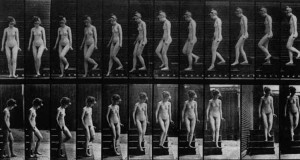
Print of Woman Descending the Stair - Duchamp may have taken inspiration from this...
Mondrian photo courtesy of Tate Britain
Muybridge courtesy of har-avantgarde.blogspot.com
Categories: 2010 Sean · Museums
September 22, 2010 · 1 Comment
The fact that the high holy days of Judaism fell during our time in London gave me an opportunity to visit and pray at several different synagogues. On Rosh HaShanah (the New Year), I first went to the Central London Synagogue in the morning. It is the Orthodox Synagogue which we visited as a class. Most of the congregation wasn’t participating in the service so it didn’t really feel very spiritual. Part of the celebration of Rosh HaShanah is to hear the shofar blown. A shofar is a hollowed out ram’s horn and it has been used to communicate in Judaism for thousands of years. I was able to hear the shofar at the Central Synagogue so I was glad I went there for that. Later in the day I headed out to the Northern suburbs of London. I attended an afternoon service with one of my flat mates from my year in Israel. His synagogue was also Orthodox but I felt a lot better about that prayer experience because everyone was participating and seemed very focused.
For Yom Kippur I had a unique opportunity to attend the only Independent synagogue in the UK. The Belsize Square Synagogue was originally founded by German immigrants but has since evolved and incorporated a number of other types of Jews. However, it still hangs onto its origins in the German Haskalah. Haskalah means enlightenment and it is the name given to the beginnings of the Reform movement. The movement began in Germany and was later adopted in the United States and elsewhere. Reform Judaism holds that a Jew should be entirely educated about the whole of Jewish law but then should be allowed to choose those elements of practice which are individually meaningful. In the United States, this is often perceived as a lax sect of Judaism and so, in most congregations that I have experienced, the members end up being mostly secular Jews and largely uneducated about Judaism in the least. At Belsize, however, I met a strange and unexpected contradiction. The service had the most obvious characteristics of a Reform service in the U.S. It had both a choir and organ and was given to churchy tunes at times. You see, the origins of the Haskalah were in a desire for German Jews to emulate their German Christian counterparts. This is evident not only in choir, organ, and tunes, but also in things like synagogue architecture and design. A Reform shul is far more likely to have pews instead of chairs, for instance. At first glance, Belsize Square appeared to be akin to Reform, in fact, the synagogue belonged both to the Reform and Liberal streams of British Judaism at different times but eventually decided it had to be independent. As I sat in services Friday night and all day Saturday, it became obvious why it was so different. The synagogue and community are amazingly traditional in their practices and attitude towards the service. I also noticed how well Jewishly-educated the whole of the congregation seemed to be. While I don’t usually go for the choir and organ, I was able to find more respect for it in the context of this shul because it seemed supported by more than just a desire to remain Jewish while acting as Christian as possible. The service was informed by a desire to remain close to the roots of the immigrant community which founded it but also to remain inextricably tied to traditional Judaism. I’ve never come across a synagogue and community like Belsize in the United States.
Categories: 2010 Daniel · Uncategorized
The first time I walked into a pub in London it was a bit like entering an alternate universe where everything is foreign and strange. It was almost like a bar scene in Star Wars. I was with a group of friends and we spent the first five minutes walking back and forth from table to bar, unsure of what to do. We stood awkwardly at the bar then awkwardly at our table, then back to the bar only to stand awkwardly a bit more. Eventually, we managed to be served which is better than I can say for a couple of times at the very beginning when, at the barman’s request, I sat down at pubs but then was never served. I still haven’t quite worked that one out. What I do know is that it was awfully confusing to be in a pub for the first couple of weeks that I was here in London.
The learning curve quickly flattened out and at the beginning of week three the pub became an event done by habit with hardly any thought involved. In that way, adjusting to pub culture is a microcosm of my acculturation into being British. At first you feel kind of weird about things but eventually they become second nature. Having visited probably over fifteen pubs since I’ve been here, I now feel qualified to make my own pub requirements like Orwell did. If I could design a pub it would:
Have good American beers (sorry for this one, Professor Qualls). I’ve become accustomed to drinking lots of delicious IPAs and Stouts which I haven’t been able to find in pubs in London. One really good IPA on draught would do wonders for my homesickness.
I agree with Orwell on this one: a pub absolutely needs a fireplace or three. Not only should a pub have a fireplace but it should also have dark wood paneling, plush carpets, and comfy couches arranged around heavy wooden tables. All of this adds to the antiqueness and hominess of the pub.
A logical extension of such cozy décor is something I’ve been told some pubs do as the days grow shorter. That is, pubs should have available delicious wintery hot drinks: hot chocolate with Bailey’s or peppermint schnapps, warm mulled wine, and hot cider with cinnamon sticks. As Fox talks about, the pub almost serves as a place of asylum, a neutral ground where the other rules of British culture melt away. Nothing would be better in helping them melt away than a nice warm alcoholic drink. England’s climate begs for it. I look forward to that in the winterier months.
Lots of good games. I realize that this might be partially against the ethic of the pub but I really like table tennis. Any pub with table tennis and a good IPA would make me a regular.
I think that about does it. I’m obviously not quite as picky as Orwell nor as cynical. I believe that I will find my pub, just as I want it, it’s only a matter of time.
Categories: 2010 Daniel
Tagged: Pubs
Parks in Korea are absolute crap – now that I’ve seen the parks in this gorgeous city. The day I went to Hyde Park, I had some yummy Alfredo fettuccine and red wine in my stomach. It was great. I gave bread crumbs to the geese and watched the sun set over the Serpentine. Meanwhile, Dave, drunk, frolicked on the grass. The vast space of Hyde Park and the more secluded areas of it, provide people with a choice: do I want to sit outside in the sun, in the open, or do I want to find a spot in the shade, amongst the animals. The experience was an unusual one, if only because I was not used to finding nature in between streets. Like everybody else, I found it amazing how a natural ecosystem could exist within the artificial confines of the city. It didn’t make any sense (still doesn’t). The fact that a fourth of London is green space is a reflection on the aims of the government in providing people a safe haven from the hustle and bustle. Indeed, one of the more interesting things I’ve observed from Hyde Park and the others parks I’ve visited (St. James, Regents, Holland), is the number of people in suits sitting on the bench or riding a bike (Barclays, of course). Plus, having parks as well constructed as the ones we’ve seen in London keeps people of the street and into safer zones (not necessarily just crime but cars and other hazards). The more I think about the park, I realize it fits the British temperament of being calm and unperturbed. I may be stereotyping a bit here, but this is something I’ve felt since the first day Emily and I went off into Marylebone to orient ourselves with the city; the people seemed so relaxed. In Korea, at least in Seoul, it is the norm to bump into people without receiving so much as an apology; people seem more tense, even apprehensive. Someone commented that they’ve seen a surprising lack of recreation in these parks. I don’t think it’s a mere coincidence. Whereas in America, we see the parks and beaches dominated by people playing volleyball, basketball, soccer, and a variety of other sports, over here, the Brits seem more inclined to take a stroll or sit on the bench and sip coffee.
While we can say that Hyde Park and St. James is very similar, we know that Hampstead is much different than Regents. Its been fun visiting these parks and noticing the small differences and peculiarities. St. James has a beautiful course that surpasses both Hyde Park (even though Hyde is still my favorite) and Regents, while Hampstead is probably the quietest park I’ve visited. It may not boast the friendly wildlife of St. James, but Hampstead was one of the most pleasurable walks I’ve had in London; the scenery was absolutely beautiful, prompting me to take photographs at every turn in the road.
Parks are reminders that urbanity needs mother nature.
Categories: 2010 Sean
Tagged: parks
September 21, 2010 · 1 Comment
We’ve visited five places of worship in our time here: the Swaminarayan Mandir, Central Synagogue, East London Mosque, St. Paul’s Cathedral, and Westminster Abbey. I include the Abbey with extreme hesitation, but ultimately do so because you have to pay if you visit like we did, but it’s free if you want to worship (look under “entrance fees”). Let’s break it down scientifically.
Mandir, Mosque, and Synagogue:
Confession (pun intended): before these three visits, I had never entered a non-Christian place of worship. I wasn’t sure what to expect, but generally found all three to be a pleasant experience. Part of me wishes we were able to go to a smaller place of worship and see a mandir, mosque, or synagogue that was strictly for research. But they probably would not be nearly as accommodating to a group of 27, and we also would have missed out on the community outreach we saw at the places that we went to. Judaism, Islam, and Hinduism are very different religions (although not as different as accounts of “religious” warfare would have one believe). One thing I saw that differentiated them as a group from the Christianity that I’m more acquainted with, though was the emphasis on serving the local community. In no way am I saying that these religions are more concerned with service than Christianity; all four religions are too massive to make generalizations like that. I am saying, however, that the Catholic churches that I’ve grown up with take collections for feeding and proselytizing faraway lands. BAPS, the Central Synagogue, and the East London Mosque were all very concerned with their very local community of believers.
St. Paul’s & Westminster:
Borderline places of worship. This did not devalue either place for me in the least; Westminster Abbey is just so mind-blowingly historic that I still haven’t figured out a way to synthesize what I saw there. And St. Paul’s remains a spectacular triumph of architectural design. Still, though, all I was able to pick up about Anglicanism in these two outings was through indirect encounters. After being in these two places, my gut tells me that the Church of England has been culturalized, that it isn’t about the faith. But I really, really wish I went to a run-of-the-mill Anglican church on a Sunday morning. Without having done that, I can’t add anything to the numbers that anyone can read.
Categories: 2010 Dennis · Churches and Cathedrals
September 21, 2010 · 1 Comment
The British Museum. Bang. Zoomph! Woop. Boom! The biggest statues, the coolest marbles, the most languages per stone, a whole bunch of the Parthenon. Beowulf. The museum is like a pirate’s hoard. It is everything awesome that the Brits could find and lug back to their island, displayed in a massive ceiling’d amalgamation of rooms with entirely uncoordinated and impossible to follow numbers that follow no logical pattern. Doesn’t get much better than that. Cleopatra’s body is there! Things that just have no business being there are all just hanging out at the British Museum and it is like it’s no big deal. You wander through the museum, stumbling upon gigantic Egyptian and Greek statues portraying God’s and mythical battles.
This brings me to an interesting point that I am sure has been discussed throughout these blogs ad nauseum. It is this British idea that somehow these priceless objects belong in the British Museum and not, say, back in their respective countries of origin. I’ll refer here to a quote from a plaque in the Greek portion of the museum.
“The Parthenon sculptures in the British Museum were brought to England by Lord Elgin and bought for the Museum in 1816. Elgin’s removal of the sculptures from the ruins of the building has always been a matter of discussion, but one thing is certain- his actions saved them further damage by vandalism, weathering and pollution. It is also thanks to Elgin that generations of visitors have been able to see the sculptures at eye level rather than high up on the building.”
Okay, let’s ignore the last sentence as the Museum is clearly grasping at straws. Obviously, the sculptures could be at eye level in Greece. Instead I’d like to focus on the phrase ‘one thing is certain.’ So that is to say that it isn’t certain that the sculptures should be back in Greece. As if both countries have a legitimate claim to the sculptures and it is a matter of debate, instead of a simple matter of Britain not wanting to give the sculptures back.
The other museum that I found truly blog-worthy is called the Welcomme Collection. It was of interest for a number of reasons. First was simply the content. One of the major exhibits I explored was on medicine, exploring its history. But what really set this museum apart was the way it was presented. The first thing I saw upon walking into the exhibit was a massive plastic model of a person, entirely consumed by bulbous fat. It had no head or features besides legs. And then there was thorough analysis on the side. This wasn’t a museum designed to wow in the way the British Museum did. It was supposed to provoke thought. The exhibit pointed out how humans had evolved in an environment in which we had to walk considerable distances and could not eat very often. And that through technology we eliminated this need to walk while also increasing the availability of calorie-rich foods. And that many developments (such as a remote control, automatic can opener) were designed to remove any sort of exercise from day to day life. But at the same time, humans are inventing products such as stationary bikes to increase artificial exercise. In the next room I came upon three chairs in glass. Two were dentist’s chairs, one from 1900 and the other from before that. The third chair was a torture chair covered in blades and hooks from Ancient China. The plaque on the side did not explain the connection between the three, but it was a shocking exhibit all the same. The final thing of interest about the Welcomme Collection was the clientele. It was mostly young people, teenagers and mid-twenties, and a seemingly alternative culture. Girls with pink Mohawks and black leather jackets, that sort. Another really cool exhibit contained an actual metal chastity belt from centuries ago, which I did not realize existed.
These two museums are particularly interesting when juxtaposed. The British Museum needs no explanation. It’s exhibits are shockingly valuable and famous. The Welcomme Collection provokes thought and puts together interesting and obscure objects.
Categories: 2010 Michael · Museums
September 21, 2010 · 1 Comment
St. Paul’s Cathedral is beautiful. I prefer it to the Westminster Abbey, which is too firmly Gothic, and thus too intimidating – even disheartening – for me to enjoy. The Mandir was beautiful, but its opulence was too demanding. Rather, I found the short service we were able to see to be the most pleasant thing about the visit. The mosque was simple but I felt nothing. The exterior of the synagogue wasn’t impressive, but its main service hall was quite a spectacle. The church, or space in which worship is held, is where religion meets art and the two become intertwined, rendering contradictions obsolete. As much as the theological aspect of our religious sojourn in in London was important, I want to emphasize just as much the self-evident, formal beauty of the physical structures that provide a spiritual retreat from the material world. Pater tells us to use our eyes in a most bare and sensuous way, to indulge in the uniformity of lines and colors of such beauty, holding nothing back in the appreciation of the aesthetic object as if one was a child.
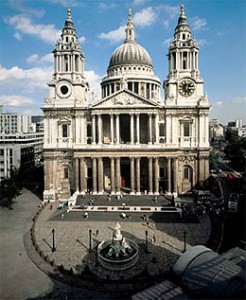
St. Paul's, exterior
While Westminster Abbey and the Mandir may have a more impressive exterior, I think the interior of St. Paul’s trumps all. I liked the presence of large, unstained windows bringing in natural light; a nice counter to the overall grandeur. (Of course, the Abbey doesn’t use clear glass so the interior is dark and gloomy, just as its exterior suggests). Furthermore, the light in St. Paul’s has the benefit of moving through an expansive space. When you step into St. Paul’s, a sense of liberation overwhelms you, a sentiment I think that has much to do with the way in which copious space and light are joined.
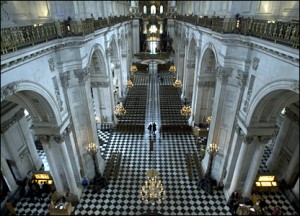
St. Paul's, Interior, Nave
There is the question, however, whether St. Paul’s, Westminster and even the Mandir is an ideal place for worship, when there is a strong emphasis on exterior beauty. I’m not a catholic nor a hindi, but having experienced small cross sections of these religions, the question persists. Can art and religion co-exist? As some people have noted, these religious institutions have become hot tourist spots, so much to the point that the spirituality has diminished. These “landmarks,” however, achieve a certain iconic status not just through its historical relevance, but through its aesthetic power. People go to see St. Paul’s because it looks so damn beautiful.
First Photo, courtesy of London Pass
Second Photo, courtesy of St. Paul’s Cathedral
Categories: 2010 Sean · Churches and Cathedrals
September 21, 2010 · 1 Comment
I’ve tried to keep my eyes and mind open in London, and I think in a lot of ways, I’ve succeeded. There have been a lot of experiences that wouldn’t have necessarily been my first choice, but afterwards I was glad I got involved in. Now that that’s out of the way, my inner fourth grader would like to make the following announcement: I don’t like museums. Never have. It would be pointless to try to present an argument justifying this, but I start out with it so the reader can understand the glasses through which I’ve viewed museums over the last four weeks.
——
The most striking feature of the British Museum has been the totally unearned and insane sense of ownership of foreign objects, particularly Elgin’s Marbles. When you go into the main exhibit containing the Marbles, here’s the first thing you see:

personal photo
Here’s an answer key, I can save you five minutes that would have otherwise been spent reading that absurd leaflet.
Because the British Museum stole them!
Lord Elgin stole them and then ran out of money and sold them to the BM!
In England!
The Parthenon sculptures back, because you stole them!
Actually, that’s the second most striking feature of the BM. Despite my previously whiny comments about museums, I couldn’t help but be totally blown away by some of the objects. Within ten minutes, you could see arguably the most famous object in history (the Rosetta Stone) and the most famous human body in history (the Lindow Man). Unbelievable.
Back to the question of ownership, though. One of the prompts for this blog entry is “What does it tell you about Britain?” Every time that I’ve seen something that seemed out of the ordinary, I’ve tried to remember to ask myself “Is that different because it’s British, or is it different for a totally separate reason?” With the Elgin Marbles, I instantly attributed the hubris of that situation to Britishness. But the same exact problem exists in a Berlin museum (you have to go to the second page of that story), among others. And I guess if I learned from museums that I can’t automatically blame the Brits for being Brits, then I learned a lot.
Categories: 2010 Dennis
In this blog I’ll just give disjointed thoughts about the different places of worship which we have visited and then thoughts on our in class conversations regarding religion. First off, I really loved the Bath Abbey. It was tremendously impressive without the pomp of many of the other places we visited. It was not so heavily touted, there was no security. It was unimposing. It was geared toward humbled devotion to God rather than self-aggrandizing homage to England’s greats, and, therefore, to England itself. Westminster Abbey and St. Paul’s Cathedral are guilty of this fault in my opinion.
The Mandir was another great experience. Marble is one of my favorite materials both for its look and feel. The hand carvings were also astonishing and I liked that we were a part of the ceremony. It was, for me, the most moving of all the religious experiences we had. I think it was especially powerful for me as it provided calm in our hectic time in London. I would like to go out to the lawn by the bubbling fountains and sit and think. We were told that the building was constructed without the use of manmade materials and I don’t know if that was it but it was a relaxing, peaceful experience.
St. Paul’s was breathtaking, the most impressive of the buildings in my opinion. The way the dome construction opens up the whole building sets the cathedral apart from Westminster Abbey (not to hate on Westminster, which was lovely.) You can soak in much of the majesty of the building all at once. It is rather overwhelming, but extremely impressive.
The mosque and synagogue did not have the aesthetic appeal of the other religious buildings we visited. The mosque visit was unfortunately short although I believe it offered a valuable insight into the perspective of the faith toward Americans. It is a jaded perspective but not unjustly so. The short duration of the tour combined with the women who pulled down the shades when they saw us in the hallway speaks volumes about the wariness towards our presence. Not, in my opinion, a word about the Islamic faith in general. That is to say that I don’t believe the Islamic faith to be closed to the public any more so than other faiths.
This reminds me of a class discussion we had in which it was put out there that our guide in the mosque was defensive about his faith and toward the questions he was asked. The evidence which was cited to support this idea was his references to similarities between Islam and Judaism and Christianity. I believe it would be more correct to simply see Islam, Judaism and Christianity as three streams which come from the same river and flow into the same sea. Not to get too metaphorical.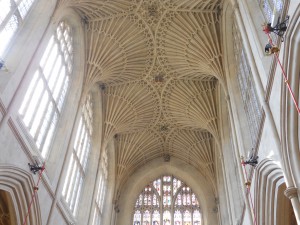
Categories: 2010 Michael · Churches and Cathedrals



